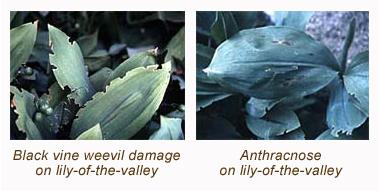
Anthracnose causes lesions that are often oval in shape and dark brown in color with purplish margins. These spots may fall out, exposing the veins. This disease is not usually fatal but does weaken the plant. The following year, the number of flowers is often reduced.
Leaf spot causes brown spots with purplish-brown margins. The spots are small and more or less round.
An insect problem that occurs occasionally on Lily-of-the-valley is black vine weevil. This insect chews notches in the edge of the leaf margins (about the size of a paper punch).
Convallaria sp. (Lily-of-the-valley) is subject to several diseases. Anthracnose, leaf spot, leaf blotch and crown rot are the main diseases. Wet conditions promote infection and spread of the disease.
Black vine weevil eggs are laid in the soil. The eggs hatch and the larvae feed on the plant roots. after pupation, the adult females feed on the leaves during the night. Feeding damage can occur from early summer into autumn. Black vine weevils never produce any males - only females.
Since the damage caused by the diseases or the insect is not fatal to the lily-of-the valley plants, no pesticides are suggested. However, if one wishes to have the plants look more pleasing, contact your state land grant university local Extension Service office for the appropriate pesticide.